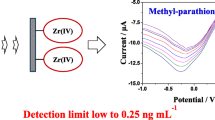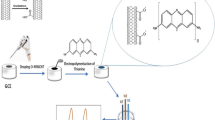Abstract
The authors describe a graphite immobilized bismuth film electrode with enhanced sensitivity for the organophosphorus pesticide paraoxon. The film was formed by ex-situ electroplating of bismuth onto the large surface of a glassy carbon electrode modified with graphite nanopowder (Bi/Gr/GCE). The modified GCE was characterized by chronoamperometry using p-nitrophenol as a model nitro compound. The modification of the GCE results in an increase of the electroactive area (to 27.7 mm2) and of the electrocatalytic activity (the catalytic rate constant being 4140 L·mol−1·s−1). This results in an enhancement of the current for the electroreduction of paraoxon by a factor of 4.3 (compared to a plain GCE). The modified GCE was applied to the sensitive determination of paraoxon by differential pulse voltammetry. At a typical working potential of −0.45 V vs. Ag/AgCl, the LOD is 2 nmol·L−1 of paraoxon, which is comparable to the LOD of some cholinesterases-based electrochemical sensors and is lower than the LOD of the organophosphorus hydrolase-based electrochemical sensors for paraoxon. In addition, the new GCE is more stable than enzyme-based sensors, and it can be renewed.

Schematic of a glassy carbon electrode (GCE) modified by renewable Bi film deposited ex situ. Graphite nanopowder (Gr) was incorporated in laponite as intermediate layer to form a sandwich-type structure (Bi/Gr/GCE). The Bi/Gr/GCE was applied for the sensitive paraoxon quantification with an LOD of 2 nmol L−1. Symbols: 1-glassy carbon electrode; 2-graphite nanopowder; 3-Bi-film. GCE: glassy carbon electrode; Bi/GCE: Bi-film modified glassy carbon electrode; Gr/GCE: graphite nanopowder modified glassy carbon electrode; Bi/Gr/GCE: graphite immobilized Bi-film electrode.





Similar content being viewed by others
References
Stoytcheva M, Zlatev R (2011) Organophosphorus pesticides analysis. In: Stoytcheva M (ed) Pesticides in the modern world-trends in pesticides analysis. InTech, Croatia, pp 143–164
Stoytcheva M (2010) Enzyme vs. bacterial electrochemical sensors for organophosphorus pesticides quantification. In: Somerset V (ed) Intelligent and Biosensors. InTech, Croatia, pp 219–230
Stoytcheva M, Zlatev R, Velkova Z, Valdez B (2011) Organophosphorus pesticides determination by electrochemical biosensors. In: Stoytcheva M (ed) Pesticides-strategies for pesticides analysis. InTech, Croatia, pp 359–372
Stoytcheva M, Zlatev R (2014) Recent trends in the development of electrochemical biosensors for organophosphorus pesticides determination. In: Aliofkhazraei M (ed) Modern electrochemical methods in nano, surface and corrosion science. InTech, Croatia, pp 83–97
Arduini F, Cinti S, Scognamiglio V, Moscone D (2016) Nanomaterials in electrochemical biosensors for pesticide detection: advances and challenges in food analysis. Microchim Acta 183:2063–2083
Garrido EM, Delerue-Matos C, Lima JLFC, Brett AMO (2004) Electrochemical methods in pesticides control. Anal Lett 37:1755–1791
Gajdar J, Horakova E, Barek J, Fischer J, Vyskocil V (2016) Recent applications of mercury electrodes for monitoring of pesticides: a critical review. Electroanalysis 28:2659–2671
Wang H, Su Y, Kim H, Yong D, Wang L, Han X (2015) A highly efficient ZrO2 nanoparticle based electrochemical sensor for the detection of organophosphorus pesticides. Chin J Chem 33:1135–1139
Anandhakumar S, Dhanalakshmi K, Mathiyarasu J (2014) Non-enzymatic organophosphorus pesticide detection using gold atomic cluster modified electrode. Electrochem Commun 38:15–18
Li C, Wang C, Ma Y, Bao W, Hu S (2005) A novel amperometric sensor and chromatographic detector for determination of parathion. Anal Bioanal Chem 381:1049–1055
Ma JC, Zhang WD (2011) Gold nanoparticle-coated multiwall carbon nanotube-modified electrode for electrochemical determination of methyl parathion. Microchim Acta 175:309–314
Huang B, Zhang WD, Chen CH, Yu YX (2010) Electrochemical determination of methyl parathion at a Pd/MWCNTs-modified electrode. Microchim Acta 171:57–62
Musameh M, Notivoli MR, Hickey M, Huynh CP, Hawkins SC, Yousef JM, Kyratzis IL (2013) Carbon nanotube-web modified electrodes for ultrasensitive detection of organophosphate pesticides. Electrochim Acta 101:209–215
Balasubramanian K, Burghard M (2005) Chemically functionalized carbon nanotubes. Small 1:180–192
Manilo MV, Lebovka NI, Barany S (2015) Stability of multi-walled carbon nanotube+laponite hybrid particles in aqueous suspensions. Colloids and Surfaces A: Physicochem Eng Aspects 481:199–206
Loginov M, Lebovka N, Vorobiev E (2014) Hybrid multiwalled carbon nanotube-laponite sorbent for removal of methylene blue from aqueous solutions, J. Colloid Interface Sci 431:241–249
Cosnier S, Lambert F, Stoytcheva M (2000) A composite clay glucose biosensor based on an electrically connected HRP. Electroanalysis 12:356–360
Du D, Ye X, Zhang J, Liu D (2008) Cathodic electrochemical analysis of methyl parathion at bismuth film modified glassy carbon electrode. Electrochim Acta 53:4478–4484
Hutton E.A, Ogorevc B, Smyth MR (2004) Cathodic electrochemical detection of nitrophenols at a bismuth film electrode for use in flow analysis. Electroanalysis 16:1616–1621
Liu ZN, Du JG, Qiu CC, Huang LH, Ma HY, Shen DZ, Ding Y (2009) Electrochemical sensor for detection of p-nitrophenol based on nanoporous gold. Electrochem Commun 11:1365–1368
Niesner R, Heintz A (2000) Diffusion coefficients of aromatics in aqueous solution. J Chem Eng Data 45:1121–1124
Zuman P, Fijalek Z, Dumanovic D, Suznjevic D (1992) Polarographic and electrochemical studies of some aromatic and heterocyclic nitro compounds, part I: general mechanistic aspects. Electroanalysis 4:783–794
Deng P, Xu Z, Feng Y, Li J (2012) Electrocatalytic reduction and determination of p-nitrophenol on acetylene black paste electrode coated with salicylaldehyde-modified chitosan. Sensors Actuators B Chem 168:381–389
El Mhammedi MA, Achak M, Bakasse M, Chtaini A (2009) Electrochemical determination of paranitrophenol at apatite-modified carbon paste electrode: application in river water samples. J Hazard Mater 163:323–328
De Souza D, Mascaro LH, Fatibello-Filho O (2011) A comparative electrochemical behaviour study and analytical detection of the p-nitrophenol using silver solid amalgam, mercury, and silver electrodes. Int J Anal Chem. doi:10.1155/2011/726462
Noguer T, Leca B, Jeanty G, Marty JL (1999) Biosensors based on enzyme inhibition: detection of organophosphorus and carbamate insecticides and dithiocarbamate fungicides. Field Anal Chem Technol 3:171–178
Jha N, Ramaprabhu S (2010) Carbon nanotube-polymer based nanocomposite as electrode material for the detection of paraoxon. J Nanosci Nanotechnol 10:2798–2802
Arduini F, Neagu D, Scognamiglio V, Patarino S, Moscone D, Palleschi G (2015) Automatable flow system for paraoxon detection with an embedded screen-printed electrode tailored with butyrylcholinesterase and prussian blue nanoparticles. Chem Aust 3:129–145
Pedrosa VA, Paliwal S, Balasubramanian S, Nepal D, Davis V, Wild J, Ramanculo E, Simonian A (2010) Enhanced stability of enzyme organophosphate hydrolase interfaced on the carbon nanotubes. Colloids Surf B: Biointerfaces 77:69–74
Chough SH, Mulchandani A, Mulchandani P, Chen W, Wang J, Rogers KR (2002) Organophosphorus hydrolase-based amperometric sensor: modulation of sensitivity and substrate selectivity. Electroanalysis 14:274–276
Lee JH, Park JY, Min K, Cha HJ, Choi SS, Yoo YJ (2010) A novel organophosphorus hydrolase-based biosensor using mesoporous carbons and carbon black for the detection of organophosphate nerve agents. Biosens Bioelectron 25:1566–1570
Deo RP, Wang J, Block I, Mulchandani A, Joshic KA, Trojanowicz M, Scholz F, Chen W, Lin Y (2005) Determination of organophosphate pesticides at a carbon nanotube/organophosphorus hydrolase electrochemical biosensor. Anal Chim Acta 530:185–189
Laothanachareon T, Champreda V, Sritongkham P, Somasundrum M, Surareungchai W (2008) Cross-linked enzyme crystals of organophosphate hydrolase for electrochemical detection of organophosphorus compounds. World J Microbiol Biotechnol 24:3049–3055
Wang J, Chen L, Mulchandani A, Mulchandani P, Chen W (1999) Remote biosensor for in-situ monitoring of organophosphate nerve agents. Electroanalysis 11:866–869
Alhassan SM, Qutubuddin S, Schiraldi DA (2012) Graphene arrested in laponite-water colloidal glass. Langmuir 28:4009–4015
Author information
Authors and Affiliations
Corresponding author
Ethics declarations
The author(s) declare that they have no competing interests.
Electronic supplementary material
ESM 1
(DOCX 60.5 kb)
Rights and permissions
About this article
Cite this article
Stoytcheva, M., Zlatev, R., Montero, G. et al. Nanostructured platform for the sensitive determination of paraoxon by using an electrode modified with a film of graphite-immobilized bismuth. Microchim Acta 184, 2707–2714 (2017). https://doi.org/10.1007/s00604-017-2282-4
Received:
Accepted:
Published:
Issue Date:
DOI: https://doi.org/10.1007/s00604-017-2282-4




